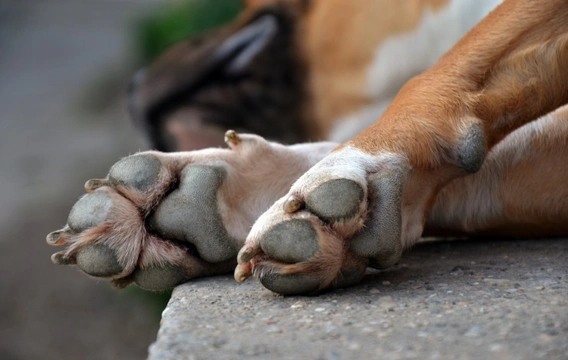
What do your dog’s carpal pads do?
Most dogs have dewclaws on their front legs and some on their hind legs too; some dog breeds can even produce specimens with double dew claws on some limbs as well. The dew claws are of course those odd, standalone claws that don’t grow from the footpads but instead, further up the leg; but whether or not your dog has dew claws, they will have an oval area of tough skin a little bit further up their front legs above the area the dew claws grow in if they are present, and this is called a carpal pad.
Not all dog owners are even aware that the dog’s carpal pads have their own specific name; and even fewer realise that this seemingly pointless part of the body can actually help your dog to do a range of different things too.
If you’re not familiar with the dog’s carpal pads or are wondering what they’re for and what they can do, this article will tell you everything you need to know.
Read on to find out what your dog’s carpal pads are designed to do.
What are the carpal pads?
The carpal pads grow on the leg just above the front paws (and if present, dew claws) the latter of which most dogs have on their front legs and some on their hind legs too. If you know what you’re looking for and where to find them (and assuming that your dog is one of the vast majority that have dewclaws) they’re easy to spot, but if your dog is very hairy and/or has a lot of feathering on their legs like the springer spaniel, you may have to part the hair to see them.
Even if your dog doesn’t have dew claws they’ll have carpal pads on their front legs, but they won’t have them on their back legs, as the roles that they perform for the dog are limited to the front limbs only, which are the limbs that make first contact with the ground and with which your dog directs their movements.
The dog’s carpal pads are in the area of their wrists, and they are constructed of the same tough, hard and multi-layered skin as your dog’s toe pads and the larger metacarpal pad in the centre of the foot, although without the accompanying claw we find on the foot pads of the dog’s toes.
Like your dog’s foot pads, the carpal pads are tough, flexible and padded out with layers of fat and thick, keratinous skin, which serves as a shock absorber, protection for the limb itself, and a type of braking system too!
Next, we’ll examine in more detail what the dog’s carpal pads actually do.
The role of the carpal pads
Due to the area of the leg that the carpal pads are located in, they don’t come into direct contact with the ground when your dog is simply walking or running normally. However, depending on the dog’s gait (and particularly if they’re running fast at a canter or gallop) the carpal pads briefly touch the ground with each cycle of the pace.
This happens very quickly with each stride, but even this very brief moment of contact with the ground can help your dog to put the brakes on in an emergency; such as if they need to make a sharp turn, or find themselves running flat out for a wall!
For this reason the carpal pads of the dog are sometimes referred to as their stopping pads, and for dogs that are involved in working roles such as herding or canine sports like agility that requires a high running speed and tight, accurate turns, the carpal pads come in very handy.
Jumping and balancing
If your dog likes to leap around chasing a ball or playing or again, if they are involved in canine sports that involve jumping obstacles, their carpal pads come into their own once again.
To land a jump effectively, your dog will come into contact with the ground with their front feet first, which creates an impact and minor shock through the body. Because of the angle and speed at which a dog lands a jump, their carpal pads once again make direct contact with the ground. This serves to check the speed of their descent so that the dog doesn’t tumble over, and to ensure that they don’t land too hard; effectively making the carpal pads a type of shock absorber that reduces jarring and provides the dog with control once on the ground once more.
The carpal pads can also help with balance and motor control if your dog is walking on surfaces that are uneven, slippery or otherwise unstable, providing a little extra traction and precision that can enable them to move around more easily and avoid taking a tumble.



